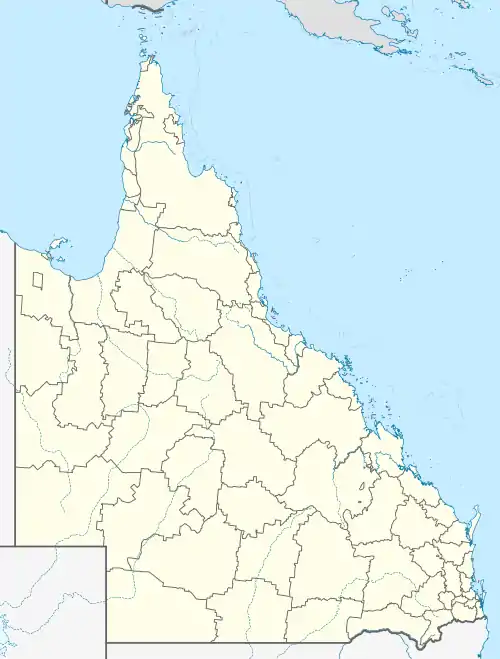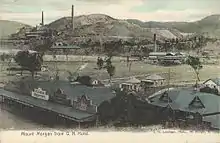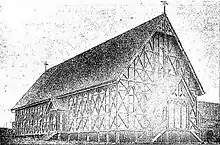Mount Morgan, Queensland
Mount Morgan is a town and locality in Rockhampton Region, Queensland, Australia.[2][3] The town was the administrative centre of the Mount Morgan Shire until March 2008, when it was amalgamated with neighbouring local government areas to form the Rockhampton Region.
| Mount Morgan Queensland | |||||||||||||||
|---|---|---|---|---|---|---|---|---|---|---|---|---|---|---|---|
 Mount Morgan's Central Business District | |||||||||||||||
 Mount Morgan | |||||||||||||||
| Coordinates | 23°39′S 150°23′E | ||||||||||||||
| Population | 1,963 (2016 census)[1] | ||||||||||||||
| Established | 1882 | ||||||||||||||
| Postcode(s) | 4714 | ||||||||||||||
| Elevation | 341 m (1,119 ft) | ||||||||||||||
| Location |
| ||||||||||||||
| LGA(s) | Rockhampton Region | ||||||||||||||
| State electorate(s) | Mirani | ||||||||||||||
| Federal Division(s) | Flynn | ||||||||||||||
| |||||||||||||||
Geography
The town of Mount Morgan is situated on the Dee River, 38 kilometres (24 mi) south of the city of Rockhampton, and is 680 kilometres (420 mi) north of the state capital, Brisbane. The Burnett Highway passes through the town.[4]
Mount Morgan's highest point of 341 metres is located at approximately 23°37′S 150°23.95′E, approximately 600 metres east of the centre of the Baree township.
History



Prior to European migrants settling in the area, the area was part of the Kangulu peoples traditional lands.
Mount Morgan was founded as a gold mining town in 1882,[5] and over time the Mount Morgan Mine has produced gold, silver and copper. Among those making a fortune from this mine was William Knox D'Arcy. D'Arcy used his fortune to finance oil exploration in Iran, which led to the formation of the Anglo-Persian Oil Company (now BP). Mining of clay in a nearby hill for the production of furnace bricks commenced soon after that time, continuing until the early 1900s,[6] The resulting man-made caves came to be known as the Fireclay Caverns, which contained large openings that measure between 4–12 metres in height from the cave floor.[7] Dinosaur footprints (preserved as infills) were later found in nine different sections of the Fireclay Caverns, lining the ceiling dated to the Early Jurassic (Sinemurian).[7][8]
Mount Morgan Post Office opened on 18 May 1885 (a receiving office had been open from 1884).[9]
Mount Morgan Central State School opened in 1887 and grew so rapidly that it was separated into two schools on different sites the following year, forming Mount Morgan Boys State School and Mount Morgan Girls and Infants State School. The word 'Central' was added to the name of these two schools from 1911. They were amalgamated back into one school in 1929. With the growth of the town during the boom years other state schools opened and operated, some for many years in close proximity. These included the Red Hill State School, Walterhall State School, and Calliungal North State School. Mount Morgan State High School was the first school of its kind to open in Queensland in 1912.[10]
The town of Mount Morgan grew in a haphazard fashion around the entrance to the mining lease near the Dee River from the early 1880s. By 1889 a number of the major religions had established congregations and erected churches including the Primitive Methodists (1885), the Catholics (1887) and the Anglicans (1889). That year the town's name was formally changed from 'South Calliungal' to 'Mount Morgan', and by 1891 the Queensland census recorded a population of 3514.[11]

The railway link between Mount Morgan and Rockhampton was not built until 1898. Until that time, everything was transported by horse teams. The Mount Morgan Mining Company had a depot in Quay Street, where the wagoners would load up. Initially, there were two routes to Rockhampton, one via Crocodile (now Bouldercombe) and the other via Kabra, Boongarry and Moonmera. In 1885, a road was built over the Razorback Range.[12]
Like many Australian towns, in 1899 to 1900, the Siege of Mafeking was avidly followed in the news in Mount Morgan. With every confidence in a British victory, in March 1900, the town's people decided to prepare to celebrate the relief of Mafeking as soon as it was announced. The town band was to assemble immediately on the corner of East and Morgan Streets and other entertainments were arranged, such as a bonfire and a greasy pig.[13] On 20 May 1900, on hearing the news of the relief of Mafeking, bonfires were lit on the hills around the town, the bands were playing, and patriotic speeches were made.[14] The celebrations did not end there, as by November 1900, a "Mafeking" bell had been installed in a tower beside the town hall.[15] The bell had been cast at the Mount Morgan Mine and weighed 7 cwt (360 kg). The sound of the bell was described as "blood curdling" and led to arguments as to whether the bell was cracked.[16] By 1955, the wooden tower had rotted and the bell was taken down to be relocated to the verandah of the town hall.[17][18] In 1969 the bell was relocated to the scout hall in Dee Street as the army leader at Mafekin was Lord Baden-Powell who established the Scouting movement in 1907.[19] In February 2018, the bell was returned to the main street of Mount Morgan as part of a streetscape redevelopment project.[20][21] There is a popular story that the schoolchildren of Mount Isa funded the bell by donating pennies (either to pay for it or to be melted down to construct it),[20][21][22] but the earliest sources so far identified for this story are from 1955,[17] 55 years after the bell was cast, and the commemorative plaque which also presents this story was not created until 1962.[23]

The Mount Morgan Mine finally closed in 1981, having produced vast quantities of gold during its lifetime. During the mining operation, most of the mountain was mined away, and the town now lies adjacent to a 43 m deep acid-water filled pit. Mining companies still prospect today in the area, and plans to extract further gold from tailings at the mine site are always under development. The Queensland Government, through its Department of Natural Resources Mines and Water have begun a rehabilitation project of the minesite.
At the 2006 census, Mount Morgan had a population of 2,447.[24]
In the 2011 census, Mount Morgan had a population of 2,115 people.[25]
Amenities
The Rockhampton Regional Council operates the Mount Morgan Library at 31 Morgan Street.[26] The Mount Morgan Public Library opened in 1993.[27]
The Mount Morgan branch of the Queensland Country Women's Association meets at the CWA Hall at 127 East Street.[28]
Heritage listings
Mount Morgan has a number of heritage-listed sites, including:
- Burnett Highway: Mount Morgan Mine[29]
- 4 Central Street: Mount Morgan State High School[30]
- 39 Central Street: Grand Hotel[31]
- East Street: Mount Morgan Cemetery[32]
- 2 Gordon Street: Mount Morgan Masonic Temple[33]
- 11 Gordon Street: St Mary's Anglican Church[34]
- 28 Hall Street: Court House and Police Station[35]
- Morgan Street: Coronation Lamp War Memorial[36]
- 28 Morgan Street: Queensland National Hotel[37]
- 31 Morgan Street: Mount Morgan School of Arts[38]
- 38 Morgan Street: Commonwealth Bank Building[39]
- 44 Morgan Street: Mount Morgan Central State School[40]
- Railway Parade: Mount Morgan railway station[41]
- Westwood/Oakey Creek: Adolphus William Copper Smelter[42]
Tourism

Tourism plays a large part in the economy of the town today, with a visitor centre located at the old railway centre and recreation area at Dam No.7. The area was host to one of the few rack railways (as part of the line from Mount Morgan to Rockhampton) to operate in Australia. The rack portion of the line was replaced by a conventional adhesion railway in the 1950s, with a small portion of track retained at the town centre.[43] In turn, the replacement line was closed in 1987, and the town no longer has a rail connection. The Mount Morgan railway station is still standing and now operates as a Museum and Tourist Information Centre. There is a regular bus service between Rockhampton, Gracemere and Mount Morgan provided by Young's Bus Service.
Events
Mount Morgan is known to hold the Golden Mount Festival in the main street at the end of April or the start of May as part of the Labour Day holiday. The festival usually starts on a Friday and finishes the next Monday. The Morgan Street is closed to vehicles during Saturday of the Festival for the day for markets and activities such as floats and "Running the Cutter" races.
Notable people
- Jens Hansen Lundager, mayor of Mount Morgan, editor of the Mount Morgan Argus, photographer
- Alma Moodie, German-based concert violinist and teacher[44][45]
- Stephen Moore (rugby union), captain of the Wallabies, lived in Mount Morgan when his family first came to Queensland
- Mervyn Henry Stevenson, superintendent of the Townsville police district and inductee of the Australian Stockman's Hall of Fame[46][47]
Gallery
 The Mafeking Bell in the main street of Mount Morgan, Queensland.
The Mafeking Bell in the main street of Mount Morgan, Queensland. The Mafeking Bell Plaque
The Mafeking Bell Plaque Mount Morgan Central State School, Mount Morgan, Queensland. It is a heritage-listed state school.
Mount Morgan Central State School, Mount Morgan, Queensland. It is a heritage-listed state school. Murals at Mount Morgan Central State School, Mount Morgan, Queensland
Murals at Mount Morgan Central State School, Mount Morgan, Queensland Mount Morgan School of Arts is heritage-listed
Mount Morgan School of Arts is heritage-listed Mount Morgan School of Arts information sign
Mount Morgan School of Arts information sign Fire Station, Mount Morgan, Queensland, Australia
Fire Station, Mount Morgan, Queensland, Australia Mount Morgan State High School is a heritage-listed state high school
Mount Morgan State High School is a heritage-listed state high school Murals at Mount Morgan State High School
Murals at Mount Morgan State High School
See also
References
- Australian Bureau of Statistics (27 June 2017). "Mount Morgan (State Suburb)". 2016 Census QuickStats. Retrieved 29 January 2018.

- "Mount Morgan – town (entry 23098)". Queensland Place Names. Queensland Government. Retrieved 28 March 2017.
- "Mount Morgan – locality (entry 48786)". Queensland Place Names. Queensland Government. Retrieved 28 March 2017.
- "Queensland Globe". State of Queensland. Retrieved 28 March 2017.
- "Tindale Tribes – Kangulu". South Australian Museum Archives. Archived from the original on 2 October 2017. Retrieved 3 October 2017.
- Staines, HRE (1954). "Dinosaur footprints at Mount Morgan". Queensland Government Mining Journal. 55 (623): 483–485.
- Romilio, Anthony; Dick, Roslyn; Skinner, Heather; Millar, Janice (13 February 2020). "Archival data provides insights into the ambiguous track-maker gait from the Lower Jurassic (Sinemurian) Razorback beds, Queensland, Australia: evidence of theropod quadrupedalism?". Historical Biology. 0: 1–7. doi:10.1080/08912963.2020.1720014. ISSN 0891-2963.
- Romilio, Anthony (20 April 2020). "Additional notes on the Mount Morgan dinosaur tracks from the Lower Jurassic (Sinemurian) Razorback beds, Queensland, Australia". Historical Biology. 0: 1–3. doi:10.1080/08912963.2020.1755853. ISSN 0891-2963.
- Premier Postal History. "Post Office List". Premier Postal Auctions. Retrieved 10 May 2014.
- "The oldest state secondary schools in Queensland". education.qld.gov.au. Archived from the original on 29 January 2018. Retrieved 29 January 2018.
- Erik Eklund, Mining Towns: making a living, making a life Archived 14 April 2014 at the Wayback Machine, UNSW Press, Sydney, 2012, pp. 75-76.
- "BACK TO COACHING AND TEAMSTER DAYS". The Morning Bulletin. Rockhampton, Qld. 7 June 1950. p. 3 Supplement: Supplement. Retrieved 3 March 2011 – via National Library of Australia.
- "MOUNT MORGAN". Morning Bulletin. LXI (10, 651). Queensland, Australia. 28 March 1900. p. 6. Retrieved 31 October 2018 – via National Library of Australia.
- "The Celebration in the Colonies". The Western Champion And General Advertiser For The Central-western Districts. XVII (435). Queensland, Australia. 22 May 1900. p. 7. Retrieved 31 October 2018 – via National Library of Australia.
- "With the Barcaldine Band". The Western Champion And General Advertiser For The Central-western Districts. XVIII (462). Queensland, Australia. 27 November 1900. p. 13. Retrieved 31 October 2018 – via National Library of Australia.
- "With the Barcaldine Band". The Western Champion And General Advertiser For The Central-western Districts. XVIII (462). Queensland, Australia. 4 December 1900. p. 13. Retrieved 31 October 2018 – via National Library of Australia.
- "MT MORGAN Place Wanted For "Mafeking" Bell". The Central Queensland Herald. 22 (1927). Queensland, Australia. 21 July 1955. p. 24. Retrieved 31 October 2018 – via National Library of Australia.
- Golding, F. L. (Frank L.) (1 January 1978), An old mining town in Queensland : Mount Morgan, Royal Historical Society of Queensland, retrieved 31 October 2018
- Rodgers, Cheryl (2007), Mount Morgan Boy Scout building and the Mafeking Bell, 2007, John Oxley Library, State Library of Queensland, retrieved 31 October 2018
- O'Dowd, Ken (8 March 2018). "Ken's Flynn in Focus". Gladstone News. Archived from the original on 23 March 2018. Retrieved 31 October 2018.
- "Mount Morgan streetscape officially opens". Rockhampton Regional Council. 23 February 2018. Retrieved 31 October 2018.
- "Information points of Mount Morgan buildings" (PDF). TMC Tours. Retrieved 31 October 2018.
- "Mafeking Bell". Monument Australia. Archived from the original on 31 October 2018. Retrieved 31 October 2018.
- Australian Bureau of Statistics (25 October 2007). "Mount Morgan (Urban Centre/Locality)". 2006 Census QuickStats. Retrieved 13 June 2011.
- Australian Bureau of Statistics (31 October 2012). "Mount Morgan". 2011 Census QuickStats. Retrieved 9 December 2015.

- "Mount Morgan Library, Public Libraries Connect". Public Libraries Connect. 1 September 2014. Archived from the original on 31 January 2018. Retrieved 31 January 2018.
- "Queensland Public Libraries Statistical Bulletin 2016-2017" (PDF). Public Libraries Connect. November 2017. Archived (PDF) from the original on 30 January 2018. Retrieved 31 January 2018.
- "Branch Locations". Queensland Country Women's Association. Retrieved 26 December 2018.
- "Mount Morgan Mine Site (entry 600751)". Queensland Heritage Register. Queensland Heritage Council. Retrieved 12 July 2013.
- "650005". Queensland Heritage Register. Queensland Heritage Council. Retrieved 13 February 2018.
- "Grand Hotel (entry 600743)". Queensland Heritage Register. Queensland Heritage Council. Retrieved 12 July 2013.
- "Mount Morgan Cemetery including Chinese Shrine and Linda Memorial (entry 600753)". Queensland Heritage Register. Queensland Heritage Council. Retrieved 12 July 2013.
- "Masonic Temple Mount Morgan (entry 600744)". Queensland Heritage Register. Queensland Heritage Council. Retrieved 12 July 2013.
- "St Mary's Anglican Church, Church hall and Bell Tower (entry 601690)". Queensland Heritage Register. Queensland Heritage Council. Retrieved 12 July 2013.
- "Court House and Police Station (entry 600745)". Queensland Heritage Register. Queensland Heritage Council. Retrieved 12 July 2013.
- "The Coronation Lamp (entry 600750)". Queensland Heritage Register. Queensland Heritage Council. Retrieved 12 July 2013.
- "Queensland National Hotel (former) (entry 600748)". Queensland Heritage Register. Queensland Heritage Council. Retrieved 12 July 2013.
- "School of Arts Hall & Library (entry 600749)". Queensland Heritage Register. Queensland Heritage Council. Retrieved 12 July 2013.
- "Commonwealth Bank (former) (entry 600746)". Queensland Heritage Register. Queensland Heritage Council. Retrieved 12 July 2013.
- "Central State School (entry 600747)". Queensland Heritage Register. Queensland Heritage Council. Retrieved 12 July 2013.
- "Mount Morgan Railway Station Complex (entry 600752)". Queensland Heritage Register. Queensland Heritage Council. Retrieved 12 July 2013.
- "Adolphus William Copper Smelter and Dee Township (entry 700013)". Queensland Heritage Register. Queensland Heritage Council. Retrieved 12 July 2013.
- "Last Days of the Mount Morgan Rack Railway" Australian Railway Historical Society Bulletin, December 1950 pp. 125–126
- Chapter9: Leisure and entertainment: aspects of popular culture at Mount Morgan Archived 24 August 2006 at the Wayback Machine
- Kay Dreyfus, Alma Moodie and the Landscape of Giftedness, 2002
- Anderson, John, "Tough bush adversary", Townsville Bulletin, 22 December 2001.
- "Fitting farewell for bush policeman", Townsville Bulletin, 22 December 2001.
External links
![]() Media related to Mount Morgan, Queensland at Wikimedia Commons
Media related to Mount Morgan, Queensland at Wikimedia Commons
- University of Queensland: Queensland Places: Mount Morgan
- Article in the Age Newspaper about Mount Morgan
- Mount Morgan State High School
- Mount Morgan Tourist Push
- Rockhampton Regional Council
- "Back to Mount Morgan". The Morning Bulletin. Rockhampton, Qld. 7 June 1950. p. 1 Supplement: Supplement. Retrieved 3 March 2011 – via National Library of Australia.
- "Mount Morgan: Its Catholic Life". The Catholic Press. Sydney. 1 August 1907. p. 40. Retrieved 19 October 2015 – via National Library of Australia.
- Town map of Mount Morgan (north), 1972
- Town map of Mount Morgan (south), 1973